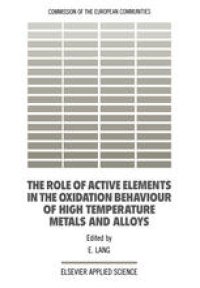
Ebook: The Role of Active Elements in the Oxidation Behaviour of High Temperature Metals and Alloys
- Tags: Metallic Materials
- Year: 1989
- Publisher: Springer Netherlands
- Edition: 1
- Language: English
- pdf
Metals and alloys rely for their application at high temperature on the formation and retention of oxide scales, which act as a barrier between the metallic substrate and the reactive species in the environment such as 0, S, N, C, Cl, etc. This protection concept requires that the oxide grows slowly, develops a dense, uniform layer, is well adherent, has sufficient ductility to accom modate plastic deformation of the substrate and is resistant to thermal cycling. For many years it has been known that small concentrations of certain "active elements" such as Y and the rare earths, as well as carbon and sulphur, can exercise a significant influence upon the oxidation! corrosion behaviour of high temperature metals and alloys. An increasing number of experimental studies on this topic have been published recently. However no generally accepted understanding with regard to the detailed mechanisms and the way in which alloy composition and structure, temperature and environmental conditions, etc., are interacting has yet been achieved, although many - often controversial - theories and ideas have been presented. It therefore seemed to be an appropriate time to bring together a group of experts to review and evaluate the current state-of-the-art and to discuss various aspects of this important topic.
Content:
Front Matter....Pages i-xiv
Front Matter....Pages 1-1
Principles of Growth and Adhesion of Oxide Scales....Pages 3-21
Oxide Adhesion on Periodic Table Group 4 and 5 Metals....Pages 23-30
Electrode Potential / Temperature Diagrams and Their Application to High Temperature Corrosion....Pages 31-31
Active Elements in Oxidation and Their Properties....Pages 33-51
Front Matter....Pages 53-53
Effect of Active Elements on Diffusion Properties of Synthetic Oxides....Pages 55-65
Effects of Impurities on the Mechanical Properties of Oxides....Pages 67-78
Front Matter....Pages 79-79
Effect of Active Elements on the Oxidation Behaviour of Al2O3-Formers....Pages 81-109
Effect of Active Elements on the Oxidation Behaviour of Cr2O3-Formers....Pages 111-129
The Influence of Active Elements on the Stress-Relaxation in the Scale and Substrate of Alumina-Forming Alloys....Pages 131-151
The Influence of Fine Structure, Morphology and Composition of Alloy and Oxide on the Growth of Cr2O3 Scales....Pages 153-153
The Effect of Yttria Dispersions on the Growth Mechanisms and Morphology of Chromia and Alumina Scales....Pages 155-173
Improvements in the Adhesion and Protectiveness of Scales Formed on Iron-Chromium Steels by the Application of Boron Compounds....Pages 175-192
Effects of Ta and Y Additions on the Oxidation and Hot Corrosion Behaviour of a ?/?? Alloy....Pages 193-193
An Alternative View of the Effect of Active Elements on the Mechanical Properties of Scales....Pages 195-223
Effect of Rare Earth Metals on Oxidation Resistance and Creep Strength....Pages 225-229
The Effects of Precious Metals on the Oxidation and Hot Corrosion of Coatings....Pages 231-267
Front Matter....Pages 269-269
The Role of Sulfur in the Growth and Adhesion of Oxide Scales....Pages 271-285
The Influence of Sulphur and its Interaction with Yttrium on the Composition, Growth and Adherence of Oxide Scales on Alumina Forming Alloys....Pages 287-297
The Role of Carbon on the Growth and Adhesion of Oxide Scales....Pages 299-314
Front Matter....Pages 315-315
Preoxidation for Sulfidation Protection of Fe-Cr-Ni-Alloys....Pages 269-269
Effects of Hydrogen Chloride and of Nitrogen in the Oxidation of Fe-20Cr....Pages 317-333
Front Matter....Pages 335-349
The Application of Active Elements in Industrial Practice....Pages 351-351
Appraisal Keynote: Future Trends and Developments....Pages 353-365
....Pages 367-374